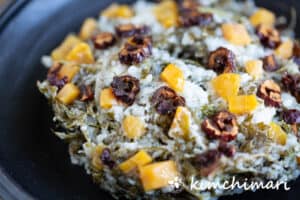What is/are Mugwort ?

Mugwort is a plant in the sunflower family that is native to Asia, specifically Korea, China, and Japan. It is a resilient plant that spreads rapidly, and can occasionally become invasive.
While it is a mountainous plant, Koreans often do not forage for mugwort as it is very common and can be easily found in grocery stores.
It is best when used while it is still young and freshly grown in the early spring. Once Summer arrives, the plant can become too tough to use for cooking, so it is often used in various ways (boiled, ground, etc.), and used as a remedy to help settle the stomach.
The plant is commonly steamed or dried, and can even be ground into a powder for rice cakes, or adding color to desserts and beverages. It is also used to make mugwort soup and rice cakes.
Where and What To Buy
Mugwort can usually be found in Korean or Asian supermarkets.
How to Clean/Store
Fresh mugwort kept in the refrigerator in a bag, or a container, and should be used as soon as possible to prevent wilting.
After cutting the roots and trimming the stalks, mugwort can be dried and stored away from direct light in the same way.
Nutrition/Health Info
Mugwort is used in traditional medicine across Asia. It is used widely during moxibustion— a process where leaves of various herbs are formed into cones or sticks, and burned over an acupuncture point to help release energy.
Please note that Mugwort has been found to stimulate women's menstrual cycles, and can potentially cause complications to pregnant and breast feeding mothers. Most doctors who practice Asian medicine would dissuade pregnant women from consuming mugwort.
On the other hand, mugwort can also treat stomach and digestive issues, and is used to treat headache, chills, fever, and even insomnia.






